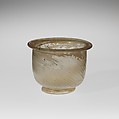Glass cup
Colorless with pale greenish tinge.
Everted rim, folded over and in, and pressed into almost horizontal mouth; cylindrical body with slightly convex side, curving to tubular foot ring, made by folding; flat bottom with low central kick and pontil scar.
Body decorated with closely-spaced shallow ribs in a spiral from top left downwards.
Intact; bubbles, blowing striations, and some gritty inclusions; dulling, iridescence, and patches of creamy weathering.
The cup is said to have been found in a Roman tomb at the ancient site of Caesaromagus in 1863, together with two glass jugs (81.10.168-169) and a coin of the Gallic emperor Postumus, which was minted between A.D. 260 and 268.
The two jugs and the cup are said to have been found in a Roman tomb at the ancient site of Caesaromagus in 1863, together with a coin of the Gallic emperor Postumus, which was minted between A.D. 260 and 268. The jugs’ attractive but rather impractical chain handles are distinctive of glassware made in the Rhineland.
[Group label: 81.10.85, .168, .169]
#1208. Glass cup
Due to rights restrictions, this image cannot be enlarged, viewed at full screen, or downloaded.

